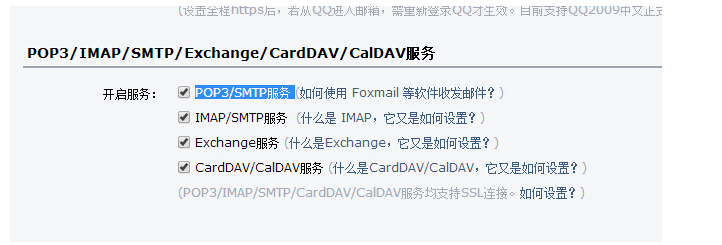使用Java應用程式發送E-mail十分簡單,但是首先你應該在你的機器上安裝JavaMail API 和Java Activation Framework (JAF) 。你可以在 JavaMail (Version 1.2) 下載最新的版本。你可以再 在JAF (Version 1.1.1)下載最新... ...
使用Java應用程式發送E-mail十分簡單,但是首先你應該在你的機器上安裝JavaMail API 和Java Activation Framework (JAF) 。
你可以在 JavaMail (Version 1.2) 下載最新的版本。
你可以再 在JAF (Version 1.1.1)下載最新的版本。
下載並解壓這些文件,最上層文件夾你會發現很多的jar文件。你需要將mail.jar和activation.jar 添加到你的CLASSPATH中。
如果你使用第三方郵件伺服器如QQ的SMTP伺服器,可查看文章底部用戶認證完整的實例。
發送一封簡單的 E-mail
下麵是一個發送簡單E-mail的例子。假設你的localhost已經連接到網路。
// 文件名 SendEmail.java import java.util.*; import javax.mail.*; import javax.mail.internet.*; import javax.activation.*; public class SendEmail { public static void main(String [] args) { // 收件人電子郵箱 String to = "[email protected]"; // 發件人電子郵箱 String from = "[email protected]"; // 指定發送郵件的主機為 localhost String host = "localhost"; // 獲取系統屬性 Properties properties = System.getProperties(); // 設置郵件伺服器 properties.setProperty("mail.smtp.host", host); // 獲取預設session對象 Session session = Session.getDefaultInstance(properties); try{ // 創建預設的 MimeMessage 對象 MimeMessage message = new MimeMessage(session); // Set From: 頭部頭欄位 message.setFrom(new InternetAddress(from)); // Set To: 頭部頭欄位 message.addRecipient(Message.RecipientType.TO, new InternetAddress(to)); // Set Subject: 頭部頭欄位 message.setSubject("This is the Subject Line!"); // 設置消息體 message.setText("This is actual message"); // 發送消息 Transport.send(message); System.out.println("Sent message successfully...."); }catch (MessagingException mex) { mex.printStackTrace(); } } }
編譯並運行這個程式來發送一封簡單的E-mail:
$ java SendEmail Sent message successfully....
如果你想發送一封e-mail給多個收件人,那麼使用下麵的方法來指定多個收件人ID:
void addRecipients(Message.RecipientType type,
Address[] addresses)
throws MessagingException
下麵是對於參數的描述:
-
type:要被設置為TO, CC 或者BCC. 這裡CC 代表抄送、BCC 代表秘密抄送y. 舉例:Message.RecipientType.TO
-
addresses: 這是email ID的數組。在指定電子郵件ID時,你將需要使用InternetAddress()方法。
發送一封HTML E-mail
下麵是一個發送HTML E-mail的例子。假設你的localhost已經連接到網路。
和上一個例子很相似,除了我們要使用setContent()方法來通過第二個參數為"text/html",來設置內容來指定要發送HTML內容。
// 文件名 SendHTMLEmail.java import java.util.*; import javax.mail.*; import javax.mail.internet.*; import javax.activation.*; public class SendHTMLEmail { public static void main(String [] args) { // 收件人電子郵箱 String to = "[email protected]"; // 發件人電子郵箱 String from = "[email protected]"; // 指定發送郵件的主機為 localhost String host = "localhost"; // 獲取系統屬性 Properties properties = System.getProperties(); // 設置郵件伺服器 properties.setProperty("mail.smtp.host", host); // 獲取預設的 Session 對象。 Session session = Session.getDefaultInstance(properties); try{ // 創建預設的 MimeMessage 對象。 MimeMessage message = new MimeMessage(session); // Set From: 頭部頭欄位 message.setFrom(new InternetAddress(from)); // Set To: 頭部頭欄位 message.addRecipient(Message.RecipientType.TO, new InternetAddress(to)); // Set Subject: 頭欄位 message.setSubject("This is the Subject Line!"); // 發送 HTML 消息, 可以插入html標簽 message.setContent("<h1>This is actual message</h1>", "text/html" ); // 發送消息 Transport.send(message); System.out.println("Sent message successfully...."); }catch (MessagingException mex) { mex.printStackTrace(); } } }
編譯並運行此程式來發送HTML e-mail:
$ java SendHTMLEmail Sent message successfully....
發送帶有附件的 E-mail
下麵是一個發送帶有附件的 E-mail的例子。假設你的localhost已經連接到網路。
// 文件名 SendFileEmail.java import java.util.*; import javax.mail.*; import javax.mail.internet.*; import javax.activation.*; public class SendFileEmail { public static void main(String [] args) { // 收件人電子郵箱 String to = "[email protected]"; // 發件人電子郵箱 String from = "[email protected]"; // 指定發送郵件的主機為 localhost String host = "localhost"; // 獲取系統屬性 Properties properties = System.getProperties(); // 設置郵件伺服器 properties.setProperty("mail.smtp.host", host); // 獲取預設的 Session 對象。 Session session = Session.getDefaultInstance(properties); try{ // 創建預設的 MimeMessage 對象。 MimeMessage message = new MimeMessage(session); // Set From: 頭部頭欄位 message.setFrom(new InternetAddress(from)); // Set To: 頭部頭欄位 message.addRecipient(Message.RecipientType.TO, new InternetAddress(to)); // Set Subject: 頭欄位 message.setSubject("This is the Subject Line!"); // 創建消息部分 BodyPart messageBodyPart = new MimeBodyPart(); // 消息 messageBodyPart.setText("This is message body"); // 創建多重消息 Multipart multipart = new MimeMultipart(); // 設置文本消息部分 multipart.addBodyPart(messageBodyPart); // 附件部分 messageBodyPart = new MimeBodyPart(); String filename = "file.txt"; DataSource source = new FileDataSource(filename); messageBodyPart.setDataHandler(new DataHandler(source)); messageBodyPart.setFileName(filename); multipart.addBodyPart(messageBodyPart); // 發送完整消息 message.setContent(multipart ); // 發送消息 Transport.send(message); System.out.println("Sent message successfully...."); }catch (MessagingException mex) { mex.printStackTrace(); } } }
編譯並運行你的程式來發送一封帶有附件的郵件。
$ java SendFileEmail Sent message successfully....
用戶認證部分
如果需要提供用戶名和密碼給e-mail伺服器來達到用戶認證的目的,你可以通過如下設置來完成:
props.put("mail.smtp.auth", "true");
props.setProperty("mail.user", "myuser");
props.setProperty("mail.password", "mypwd");
e-mail其他的發送機制和上述保持一致。
需要用戶名密碼驗證郵件發送實例:
本實例以QQ郵件伺服器為例,你需要在登錄QQ郵箱後臺在"設置"=》賬號中開啟POP3/SMTP服務 ,如下圖所示:

Java 代碼如下:
// 需要用戶名密碼郵件發送實例 //文件名 SendEmail2.java //本實例以QQ郵箱為例,你需要在qq後臺設置 import java.util.Properties; import javax.mail.Authenticator; import javax.mail.Message; import javax.mail.MessagingException; import javax.mail.PasswordAuthentication; import javax.mail.Session; import javax.mail.Transport; import javax.mail.internet.InternetAddress; import javax.mail.internet.MimeMessage; public class SendEmail2 { public static void main(String [] args) { // 收件人電子郵箱 String to = "[email protected]"; // 發件人電子郵箱 String from = "[email protected]"; // 指定發送郵件的主機為 localhost String host = "smtp.qq.com"; //QQ 郵件伺服器 // 獲取系統屬性 Properties properties = System.getProperties(); // 設置郵件伺服器 properties.setProperty("mail.smtp.host", host); properties.put("mail.smtp.auth", "true"); // 獲取預設session對象 Session session = Session.getDefaultInstance(properties,new Authenticator(){ public PasswordAuthentication getPasswordAuthentication() { return new PasswordAuthentication("[email protected]", "qq郵箱密碼"); //發件人郵件用戶名、密碼 } }); try{ // 創建預設的 MimeMessage 對象 MimeMessage message = new MimeMessage(session); // Set From: 頭部頭欄位 message.setFrom(new InternetAddress(from)); // Set To: 頭部頭欄位 message.addRecipient(Message.RecipientType.TO, new InternetAddress(to)); // Set Subject: 頭部頭欄位 message.setSubject("This is the Subject Line!"); // 設置消息體 message.setText("This is actual message"); // 發送消息 Transport.send(message); System.out.println("Sent message successfully....from cnblogs.com"); }catch (MessagingException mex) { mex.printStackTrace(); } } }



